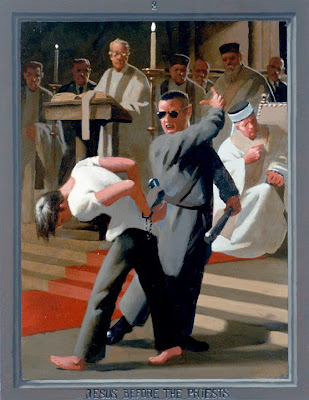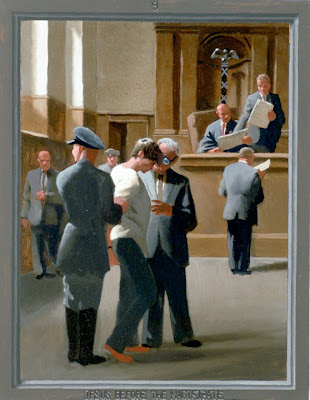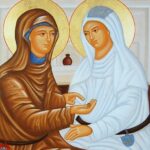Last Updated on April 13, 2025 by Kittredge Cherry
“One of the officers standing by struck Jesus with his hand, saying, ‘Is that how you answer the high priest?’” — John 18:22 (RSV)
A guard hits Jesus in a house of worship while clergymen do nothing, indifferent to the violence in “Jesus Before the Priests” from “The Passion of Christ: A Gay Vision,” a series of 24 paintings by Douglas Blanchard. The blow is so hard that Jesus doubles over. The guard’s dark sunglasses cannot hide his hateful grimace. A bespectacled priest looks up from an open Bible, but his bland face registers no concern for Jesus. Another cleric deliberately ignores the assault, studying his fingernails. Red carpet on the steps leads to an altar with candles. Watching from the back are more white-robed priests and men in business suits.
 This is one of the more shocking images in Blanchard’s Passion series because it exposes blatant religious hypocrisy in an ordinary contemporary setting. The church and its ministers look familiar, maybe even comforting or boring. One might expect violence from police or soldiers on the streets, but not in a church sanctuary with approval from the priests. In the banality of evil, unspeakable acts are committed not by monsters, but by regular people who accept the premises of an institution and follow orders.
This is one of the more shocking images in Blanchard’s Passion series because it exposes blatant religious hypocrisy in an ordinary contemporary setting. The church and its ministers look familiar, maybe even comforting or boring. One might expect violence from police or soldiers on the streets, but not in a church sanctuary with approval from the priests. In the banality of evil, unspeakable acts are committed not by monsters, but by regular people who accept the premises of an institution and follow orders.
“Jesus Before the Priests” is based on the Biblical story of Jesus’ trial before Caiaphas, the high priest in the Jewish court of the Sanhedrin. After his arrest Jesus was judged first by his own people. He had threatened their power structure by living in a way that showed God is not confined to dogmatic boxes or controlled by religious institutions. The priests hurriedly called an emergency session of the Sanhedrin in the dead of night. The specific charge against Jesus was blasphemy. False witnesses were brought in to accuse him, but their testimony was inconsistent. During hours of questioning Jesus mostly kept quiet, giving only a few cryptic answers. Finally they declared him guilty. Then the priests spat in his face and beat him before hustling him off to the Roman authorities for sentencing.
The Sanhedrin trial has never been an especially popular subject in art history, but Blanchard finds the inherent drama in the scene by approaching it from a contemporary gay viewpoint. LGBT people often come into conflict with churches because of who they love. When viewed with queer eyes, this painting is a painful reminder that it feels like a slap in the face to be told that God condemns homosexuality or “hates the sin but loves the sinner.” LGBT people have been attacked with “clobber passages” from the Bible or tortured in “pray the gay away” therapy, also known as reparative or ex-gay conversion . While today’s LGBT artists mostly ignore the trial of Jesus, several have exposed the ancient purity laws that threaten queer people. For example, Swedish artist Elisabeth Ohlson Wallin photographed local LGBT people in Jerusalem with the dreaded scriptures projected on or near their bodies in her 2010 “Jerusalem” series.
Conservative Christians cherry-pick Bible verses from Leviticus to condemn homosexuality on religious grounds, but these rules do not necessarily apply today. The passages refer specifically to sex with male temple prostitutes in the fertility cults of the neighboring Canaanite nations. They were only intended to stop ancient Jews from adopting the idolatrous practices of other cultures, not as a blanket prohibition on same-sex relationships forever. Anyway Christians need not try to enforce laws from Leviticus. The New Testament firmly rejects imposing the old purity code on new Gentile Christian converts because Jesus replaced the old laws with the new commandment to love. Many of the other laws in Leviticus were abandoned by Christians long ago. In addition to its sexual rules, Leviticus also outlaws tattoos, eating shrimp, reading horoscopes, and wearing blended fabrics.
Religions have labeled queers as “sinners” and then refused to accept responsibility for the violence that they incited. A 21st-century example occurred in Uganda, where a law that imposed the death penalty for homosexuality was drafted under the influence of Christian conservatives from America. Church trials for homosexuality continue in America too. Priests, ministers, and congregations are still being found guilty and rebuked, ousted, expelled, shunned, or silenced for such “crimes” as speaking in favor of LGBT rights, performing same-sex marriages, or ordaining LGBT clergy. Queer Christian art has been denounced as blasphemy, the same crime for which Jesus was condemned.
The ugly pattern is repeated with other groups. The Bible teaches love, but it has been used to justify slavery, wife-beating, genocide, and other horrors. “Jesus Before the Priests” sums up all religious hypocrisy in a single image. Religion, which supposedly promotes peace, justice, and love, instead has often become the impetus for war, discrimination, and acts of hate. Christians claim to follow Jesus, but if he showed up today they might reject him as a heretic and a troublemaker, just as the priests did 2,000 years ago.
___
“But he gave him no answer, not even to a single charge; so that the governor wondered greatly.” — Matthew 27:14 (RSV)
A defendant refuses to accept a plea bargain in “Jesus Before the Magistrate.” Jesus is caught between his lawyer and a guard wearing knee-high military jackboots. Dull men in suits are shuffling papers, but nothing seems to happen in the generic courtroom. All of them, even the judge, look like faceless pawns in a menacingly complex bureaucracy. There is no jury. A pole behind the judge’s bench is topped by an eagle, a symbol shared by imperial Rome — and the United States. In this antiseptic setting, impartial to a fault, Jesus is found guilty of treason and sentenced to death.
This painting is a modern version of Jesus’ trial before the Roman governor, Pontius Pilate. The Bible says that after the priests found Jesus guilty, they took him to the governor for a second trial. Jesus was a Jew convicted blasphemy under the laws of his own people, but this was no crime in the eyes of the Roman occupation forces. The priests wanted Jesus executed, so they switched the charge to treason, a capital offense under the law of the Roman government that occupied their land. The Bible is packed with juicy dialogue, characters, and details about the interrogation and interactions between Jesus and Pilate. The episode has been dramatized — and sometimes over-dramatized — as the first stop in the traditional Stations of the Cross. The sensational scene has been a crowd-pleaser in medieval Passion plays and contemporary films about the life of Christ. In all four gospel accounts Pilate tries various tactics to avoid responsibility for killing Jesus. The angry mob and the seriousness of the charges eventually force Pilate to authorize the death penalty. The Roman and Jewish leaders were enemies, but they agreed that the man who loved without limits should die.
Jesus’ trial before Pilate is one of the most enduring images in Christian art, dating back to fourth-century sarcophagi in the catacombs of Rome. Some artists portray Pilate as a harsh tyrant or a clever politician, but Blanchard opts to show him as an uncaring bureaucrat, too bland to make a memorable villain. This painting takes the whole overblown scenario and strips away the embellishments that have been cultivated by countless artists over the centuries: There are no priests accusing Jesus of “perverting” the nation. Jesus does not engage in one-on-one repartee with the governor. King Herod, Barabbas, and Pilate’s wife never appear. Pilate does not ritually wash his hands to absolve himself. Blanchard condenses all the action into a single, simple scene. The understated result is one of the most tranquil images in his whole Passion series. The painting gets at the unvarnished truth: Jesus was a nobody in the Roman justice system. The decision to kill the child of God was no big deal. It happened without fanfare, and it could happen again now somewhere closer to home. Ultimately Jesus was executed for treason, but his “crime” might have gone by a different name in another time and place.
Queer people can relate to the experience of a man trapped in a system that is rigged against him. The deadly oppression begins with words of insult that serve to demonize and dehumanize a target group, paving the way for acts of violence. This hard truth is illustrated in “Stations of the Cross: The Struggle For LGBT Equality” by Tennessee artist Mary Button. In Station 1 she juxtaposes Jesus being condemned to death with the first use of the gay insult “faggot” in print (in a 1913 guide to criminal slang). Name-calling can escalate to assault. Anti-gay slurs are part of the continuum of oppression that includes murder by those who aim to purge society of sexual minorities. The scene of Jesus with the governor is also played out in courtrooms around the world. Many countries still outlaw same-sex acts between consenting adults, and a handful of nations punish them with death. Even where there is no state-sponsored persecution, people are fighting to pass laws that recognize same-sex unions and protect LGBT people from discrimination.
___
Next: Day 5: Jesus before the people
or see the whole series “The Passion of Christ: A Gay Vision.”
The Passion series features 24 paintings by Douglas Blanchard, with text by Kittredge Cherry. It is also available as a book and prints.
Donate now to the 2025 Palm Sunday/Holy Week offering to support this series.
___
To read this article in Italian, go to:
Gesù davati ai sacerdoti, a Pilato e alla folla (gionata.org)
___
Top image credit:
8. Jesus Before the Priests (from The Passion of Christ: A Gay Vision) by Douglas Blanchard
This article was originally published on Q Spirit in April 2017, was expanded with new material over time, and was most recently updated on April 12, 2025.
Scripture quotation is from Revised Standard Version of the Bible, copyright © 1946, 1952, and 1971 National Council of the Churches of Christ in the United States of America. Used by permission. All rights reserved.
Copyright © Kittredge Cherry. All rights reserved.
Qspirit.net presents the Jesus in Love Blog on LGBTQ spirituality.




















You claim: “He had threatened their power structure by living in a way that showed God is not confined to dogmatic boxes or controlled by religious institutions.” which is not remotely what Jesus actually said, in fact there’s even a quote stating that people should obey the religious authorities because they are “on the seat of Moses” but while telling people to avoid their hypocritical refusal to obey the Commandments, which Jesus described bluntly several times as the Pharisee’s actual problem (i.e. they refused to obey the major elements of the moral law while fixating on small things like ritual washing of hands, tithing etc). You also claim that “conservative Christians” only cite one passage in Leviticus to show that homosexual sex is a sin, but in reality there are quite a few passages, mostly in the New Testament, as well as much more explicit statements by the mystic saints such as Catherine of Siena, Hildegard von Bingen, etc. All of these sources confirm each other. You likewise claim it’s hurtful to say that God “condemns the sin but loves the sinner” while you constantly condemn plenty of sins yourself. So we’re not allowed to condemn the sins you personally want to commit while you are free to condemn anything you want? That sounds like hypocrisy, and certainly is not in keeping with Jesus’ many statements condemning plenty of sins (and yes, Jesus’ recorded quotes do not specifically mention homosexual sex but neither do they specifically mention pedophilia, rape, kidnapping, or countless other things which are nonetheless known to be sinful. He didn’t need to reinterate every single aspect of the accepted moral law of the time, but instead tended to naturally focus on condemning behaviors which had become accepted in 1st century Judea since the people of the time needed to be corrected on those issues).